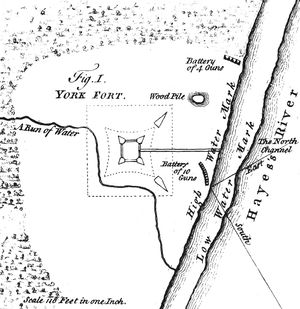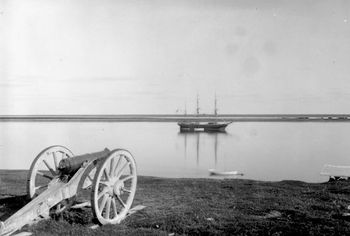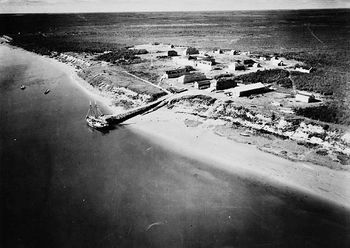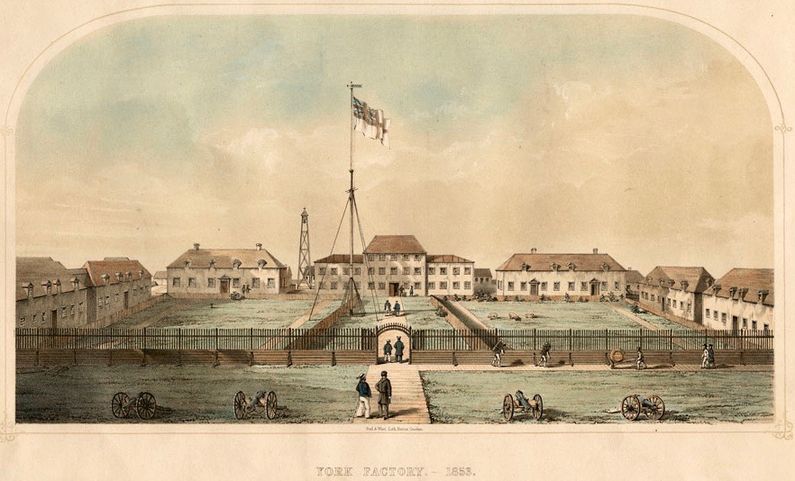York Factory
|
York Factory (1684-1957) - A Hudson's Bay Company fur trading post and fort first established in 1684 on Hudson's Bay in Manitoba, Canada. Abandoned as a fur trading post in 1957. Also known as Fort Bourbon, Fort York and York Fort.
York Factory I (1684-1715)Established in 1684, the Hudson's Bay Company built York Fort on the north shore of the Hayes River, eight kilometres upstream from Hudson's Bay. Between 1694 and 1697, the French and English battled for control of the original York Factory. Under Pierre Le Moyne d'Iberville, the French captured York Factory in 1694, lost it back to the English in 1696, recaptured it 1897, and renamed it Fort Bourbon. The post remained under French control until the Treaty of Utrecht in 1713 awarded the Hudson's Bay Company exclusive trading rights on Hudson Bay. Captain James Knight, HBC Governor, and Henry Kelsey, Deputy-Governor, repossessed York Factory In 1714 and found it in ruins and impossible to repair. A new site was selected about half-mile downstream. York Factory II (1715-1788) By October of 1715 the new fort was completed enough to move into. The next year they erected palisades around it. In 1718 Kelsey reported they were still adding to the fort. In 1782 HBC posts were attacked by French admiral, Comte de la Pérouse, who was harassing British posts in support of the American Revolutionary War. He launched a massive attack on York Factory with 250 men. The HBC garrison saw the French ships approaching and quickly loaded York's furs onto a ship and sailed away. They saved York's goods but Comte de la Pérouse burned the post down. Joseph Colen started to rebuild in 1785 on the same site. The rebuild ended in 1788 when the Hayes River rose 32 feet and flooded the site, forcing Colen to find a new site.
York Factory III (1788-1832)A new site was selected by Colen in 1788 on higher land upstream from the York Factory II site. He built the new post between 1788 and 1795 as a stone fort. It was known as the "Octagon" because the trace of the inner courtyard formed an octagon. The Octagon was really a square fort with five-sided bastions at each corner (also known as "Flankers"). Between each of these bastions were rectangular rooms called curtain sheds. The forts was defended by shooting from the bastions, along the outside walls of the curtain sheds (enfilading fire). The fort was entered only through a main gate. Each bastion and curtain shed was entered only from the central courtyard. By 1831 the Octagon had to be replaced. The rigid stone and brick foundation and the solid wood and brick walls were not flexible enough for the heaving and pressure of the permafrost. Both the foundations and the building quickly deteriorated and could not be used. York Factory IV (1832-1957)The design of the new York Factory evolved as a simple and utilitarian concept. The buildings of the fort were laid out in an "H" shape with the main depot building or "Great House", the guest-house, and a summer mess house forming the center bar. The wings of the "H" were composed of fur stores, provision shops, trading rooms, officers' and servants' quarters. The central buildings were surrounded with a palisade with the main gate directly in line with the entrance to the depot. York Factory closed as a fur trading post in 1957. Current StatusNow part of York Factory National Historic Site of Canada. Main factory building, two outbuildings, two ruins and a cemetery remain at the York Factory site in Churchill, Manitoba. The site is seasonally staffed by Parks Canada from June 1 to mid-September. Archaeological excavations of the 18th-century "octagon" have been conducted since 1991.
See Also: Sources:
Links: Visited: No | ||||||


